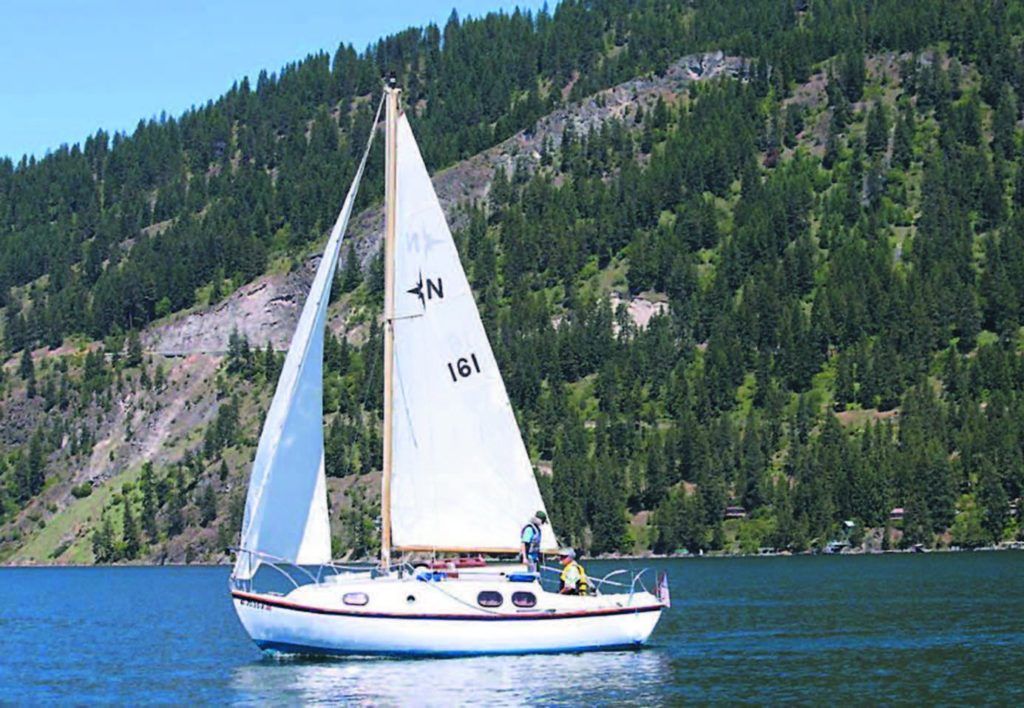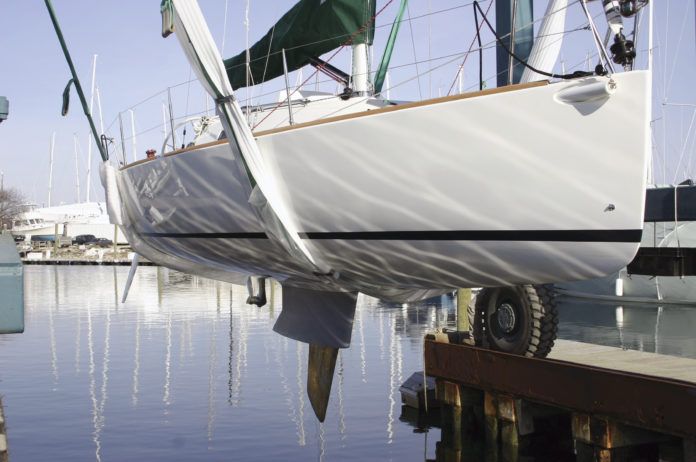The popularity of our recent discussion of shoal draft boats prompted a dive into the archives on related topics, and we were delighted to see the name Warwick Collins pop up. Collins, the inventor of the tandem or “Collins keel,” died in 2013, but his name frequently appears up in boat design forums today. For those unfamiliar with Collins, he was typical of the eccentric personalities who often rise to the top in the field of sailboat design—a creative genius whose talents spread into a wide range of forums. In Collins case, the pursuits included poet, novelist, evolutionary biologist, and naval architect. And of course, inventor of the Collins keel—a design which incorporated two efficient foils joined by a ballasted foot. Do a Google image search for “Collins keel,” and you’ll see several variations.
The fact that this PS Advisor Q&A from more than three decades ago (PS January 1989) is just as salient today as it was then (the tandem’s close relative, the canard keel is a fundamental aspect of can’ting keel racing designs today) illustrates how innovation in foil and hull forms still relies as much on the imagination of creative geniuses like Collins as it does on computer algorithms.
One shallow-draft keel form that this article doesn’t mention is the bilge keel, which is seeing a bit of a resurgence today. Also missing is the ancient leeboard design. If you are the proud owner of a bilge-keeler or leeboard boat, we’d be interested in hearing from you in the comments below, or e-mailing us at practicalsailor@belvoir.com.

Here’s the original excerpt from PS Advisor January 1989, featuring a question from a reader in Tampa, FL, where shoal draft can greatly expand cruising grounds:
I read your comments on the shoal draft tandem or canard keel by the Englishman Warwick Collins. While you praised the keel, you really didn’t answer the main question for those of us who are looking for a new boat with shoal draft.
Which is the preferred keel for shoal draft? Wing? Scheel? Collins? Centerboard? The old-fashioned long, shallow keel?
Part of it depends on the hull. You can’t just stick any keel onto any hull-there has to be a marriage between the two. The long shoal keel, for example, would be a disaster as a replacement for the fin on a typical modem flat-bottom hull, and the fin a disaster on the deeper, round-bottom hull. So the following comments assume that there’s a satisfactory union between hull and keel. Practical Sailor published an in-depth report on keel-hull connections in the wake of recent failures.
We think the Collins or canard keel looks promising, but we’d have to say it is still not adequately proven. It probably does offer better performance than a conventional keel of the same depth, but it’s not clear that its performance is superior to the other shoal-draft options. There’s also a bit of structural concern with the keel, in that it just about has to be made of iron or steel to have sufficient strength. Wing keels have some of the same problem, but a lead version of the Collins keel could probably deform badly in a hard grounding.
We remain skeptical of the wing keel. While a well-designed one can perform comparably to other shoal-draft keels, we see many wings that are questionable. We walked through the New York Boat Show in 1989 with a naval architect who had designed wing keels for the America’s Cup boats, and his judgment was that every wing at the show was poorly done—sometimes appearing less efficient than a wingless keel of the same depth. In addition, of course, you always have the potential problem of snagging lobster pots or kelp, especially with wing keels that have reverse slope front edges (which they apparently need to be truly efficient).
The Scheel keel is pretty well proven by this time. We think it’s a better bet than the wing, if you have that choice, and overall a good moderate design for shallow-draft cruising. Performance isn’t bad-in racing, both PHRF and IMS show that the Scheel keel is about 5 to 12 seconds per mile slower than a deeper fin on otherwise identical boats.
However, we think the best bet is the modern keel/centerboard. Unlike centerboards of 20 years ago, the new ones are very efficient going to windward with the boards down and not all that bad with the boards partially raised or withdrawn into a stub keel.
For the two boats we’ve recently sailed on-a C&C and a Sabre—our impression was that even with the board retracted the boats sailed about as well as comparable wing-keelers or Scheel keel boats. Maintenance, especially keeping barnacles and weeds out of the inside of the centerboard case, is a problem, and the tackle to raise and lower the board is a minor complication in rigging.
But otherwise they seem best—good performance with shallow draft, and excellent performance when you drop the board fully. For people who like getting into the nitty gritty of foil design, designer Eric Sponberg produced an informative analysis a while back. Ralph Naranjo also reflected on keel preferences in his in-depth report on keel design.


































The Horizon Cat design by Com-Pac was a good answer to Florida west coast cruising with all the shoal waters. The stub keel provided ballast and together with a small amount of the bilge, provided the centerboard housing without intruding into the living space. The board is long enough for good lateral resistance and provides easy management with a pennant towards the tip led to a clamshell cleat on the cockpit sole. I have been exceptionally happy with the combination (and the early heads up when I wander into shallow water!).
The keel/centerboard on Little Harbors(Ted Hood Sr)—I had a 38 footer for 14 years–was phenomenal. Go to weather?? Like a bullet. Did 4 Regatta D-Amigos races with her(Galveston /Vera Cruz), 620 NM , hard to weather most of the way into strong S/SE winds . She was in Trophy range in each race.
Would have a larger one today except they quit making them and the larger ones were/are very expensive.
I sail an 87 Sabre 42 CB. i love the keel…we can point with newer boats with a deep keel such as a 2003 SunFast 37 with the board down, but only draw 5′ with the board up. Yes there are negative aspects, such as the maintenance issues involved, but for us, the benefits have outweighed the negatives.
Everything is a trade off….Is there the best all around design?
I’m a twin-keel sailor in Southern Florida. I’ve owned and sailed four, a Vivacity 20, a Westerly 25 and a pair of Westerly Pageants (23′). I’m based in Sarasota, on the west coast where the Gulf waters are warm and blue, but the estuarine waters are brown and shallow.
Advantages:
Stiff: With a roughly 40% ballast ratio, the boats are stiff and can handle real wind without extreme heel.
Shallow draft: The Vivacity drew 2 feet, and the Pageant is 2’10”. And both can be run aground without fear. This makes gunk holing an adventure instead of a peril. And no underwater parts to break or shear.
Maintenance: pull up on a scenic sandbar and scrape the bottom, a fun summertime enterprise. Just don’t forget to figure out the tides.
Stability: one of the Pageants had a vane-only self steering device, with no pendulum or aux rudder in the water. It once made the 48 hour trip from Sarasota’s New Pass to the Dry Tortugas entirely on the vane. A sheet-to-tiller system is almost as reliable, although with more variation due to “system” lag.
Volume: by their nature, twin-keep designs are beamier than similar-sized single-keel designs. This provides separation for the keels. Thus interior space is larger, with more storage bins etc.
Strength: most twin-keel boats are British, and are built for use in areas with large tidal ranges. Slips must accommodate serious water level changes, and are expensive to rent. Many twin-keelers regularly “take the bottom” on their moorings, day after day after day, with all the associated pounding.
Dry: all four of my boats had bilge spaces so dry I could store postage stamps there. Finding water in the bilge was a rare event, usually due to leaving a port or hatch open in a rain. With a dry bilge, mildew was held at bay if you had some through-cabin ventilation.
Posture: sits upright when in the boatyard; no jack stands required. Much better stability on a trailer (use a flatbed if you want).
Disadvantages:
Speed: more wetted area, so slower. Over the very long haul, I average about 3 knots for planning purposes. Mind you LWL is about 17 feet.
Pointing: doesn’t sail well at the “edge” going to windward. Performs best about 50-55 degrees of the wind.
Barnacles: with more underwater surface, more opportunity for barnacles to grow.
Racing potential: last place every time.
For family sailing and cruising, we’ve found bilge keelers to be an obvious choice for southwest Florida. They are blue-water capable, but shine in shallow waters. Roomy, airy, comfy. All boats are compromises, and sailors should be serious about what they want to accomplish. My Pageants were designed to take a family of four across the English Channel for a visit to France. While France is a long way from Sarasota, they continue to be seaworthy and sea-kindly cruisers.
Now that is a proper review of a bilge keel, all the main pros and cons broken down, easy to understand and broken down into easy to visualise information.
Thanks
Very helpful as I’m looking to trade a Hunter 27 for a twin-keeled boat… Thank you!
What about the swing keel on Southerly boats? Not sure if they fall into the shoal draft category but I find the capabilities of these boats particularly intriguing!
I have had two excellent experiences with low draft boats. The first in a southerly 115, about 35 ft, design Dick Carter. A cast iron slab on the bottom of the boat with two prominent chines could take easily with a shallow draft of 3 ft and then perform even better with a retractable quarter round fin operated by a simple tackle inside the boat. Loved it and loved the downwind reduced resistance that could be measured in almost 1 knot. The second experience was the shallow draft of a 24 ft trimaran ( Farrier 720 trailer tri). This stuck me with multihulls, not because of the speed, but for the ability to navigate shallow waters and hop onto a beach without a dinghy. Unbeatable.
TANZER 7.5 is the best 25′ boat that ever crossed the ATLANTIC with a Shoal Keel?
Is this true?
https://sailboatdata.com/sailboat/tanzer-75
I am a yacht designer specializing in shoal-draft cruising sailboats. My designs are all over the world, in the hundreds. These include small craft like sharpies, Sea Bright skiffs and skipjacks, as well as large cruisers up to 75-feet. Most of these are true traditional-looking centerboard designs with long, traditional drag keels, but some have keel-centerboard configurations. I write about yacht design and construction for WoodenBoat Magazine and Professional Boatbuilder Magazine. I have three books in print about boat design, construction, history and cruising. I live aboard a 53-foot ketch with a draft of 3-feet board up, and 7′ 6″ board down. She is an excellent gunkholer as well as a proven offshore sailor.
What is a drag keel?
“”A keel centreboard configuration ” means stub keel with centreboard or perhaps a drop/lifting keel that doesn’t swing?